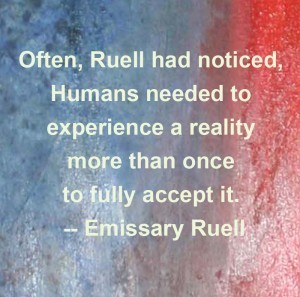Making a Point
As writers, we have to step into our characters’ skins and know them. In writing Emissary, I became, at various stages, a Houston cop, the US president, the president’s press secretary, a vicious dictator, a mercenary, and an emissary from a dying planet.
This can be great fun.
It can also be eye-opening. Regardless of what we choose to show the reader, we have to know not only our characters’ best traits but their worst, their strengths as well as their imperfections, their thoughts and, no matter how alien to us, their feelings.
Emissary Ruell is young and inexperienced yet desperate to save the refugees from his lost world. To accomplish his mission, he is experiencing Humans up close and personal. I had to ask myself what he would notice about us.
One thing—out of many—is that we aren’t easily convinced. Sometimes we don’t notice what’s right in front of us, other times we might choose to ignore it, and occasionally we disbelieve no matter how compelling the evidence.
Our readers are Human. In crafting a story, we might need to make them pay particular attention at one point but miss another point entirely. Here’s how we do it:
To make a point stick, embellish it with sensory variation.
Example: Tommy is sick but doesn’t want his mom to know. He thinks, Gosh, my stomach feels wonky. He hears his older brother yell, “Mom, we’ve got to go. The game starts in ten minutes!” He sees his new shirt in the school’s game colors. He rushes toward the toilet but vomits on the bathroom floor, then hurriedly wipes it up with a towel. Rinsing the taste of bile from his mouth, he notices his grim expression in the mirror and forcibly changes it to a smile before facing his mom.
Here’s the lazy way: Tommy felt sick, but he wanted to go to the game.
The first example uses more words, but doesn’t it make the point sink in?
PRE-ORDER Emissary now at charthousepress.com/books/emissary





